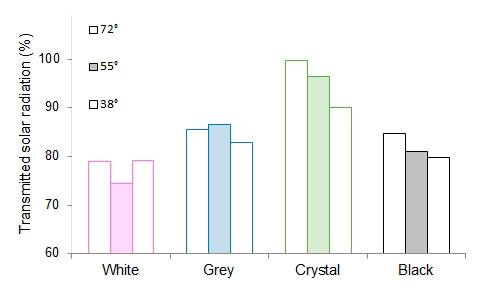The light that got through
(continued from last issue)
When the plane of the netting was approximately perpendicular (i.e. 72°) to the solar beam—which is similar to the solar angle in relation to flat roofed netting in mid-summer at midday—incoming solar radiation (i.e. no netting) peaked at wavelengths from 450–900 nm and then steadily declined to 2500 nm with several troughs at approximately 950, 1150, 1400 and 1900 nm (see Figure 1).
The effects of grey and black netting on the proportion of solar radiation that was transmitted were similar and did not vary with wavelength whereas the white netting varied with wavelength.
The crystal netting had very little impact on incoming solar radiation.
Reducing the incident solar angle reduced the amount of transmitted solar radiation (and its constituent components of photosynthetically active and infrared radiation) under the crystal and black netting. This was most noticeable under the crystal netting (see Figure 2).
In other words, transmitted solar radiation would be less in the morning and afternoon under flat roofed crystal and black netting.
Interestingly, transmitted solar radiation under the white netting was similar at the highest and lowest incident solar angle. Additional observations under the netting showed that diffuse radiation more than doubled at the lowest incident solar angle suggesting that under white netting there is no effect of netting roof angle on transmitted radiation due to the scattering of light as it hits the netting filaments.
Implications for growers
These results have implication for sun damage, photosynthesis and colour development.
Red colour development in apples needs light in the range 430–655 nm and is stimulated by ultraviolet B radiation (280–320 nm). Similarly, the wavebands needed for photosynthesis are 400–540 nm and 600–630 nm.
On the other hand, sun damage is more associated with the infrared spectrum (> 700 nm) as approximately 49 per cent of the energy from solar radiation is from infrared radiation.
Results from this study showed that the white netting reduced photosynthetically active radiation more than the reduction in infrared radiation whereas the reduction in photosynthetically active and infrared radiation was similar for black and grey netting.
The ideal netting would maintain high values of transmitted photosynthetically active radiation while reducing transmitted infrared radiation across a range of incident angles.
Contact Ian Goodwin, DEDJTR, Victoria
E:
P: 03 5833 5240
See this article in Tree Fruit Nov 2018




















